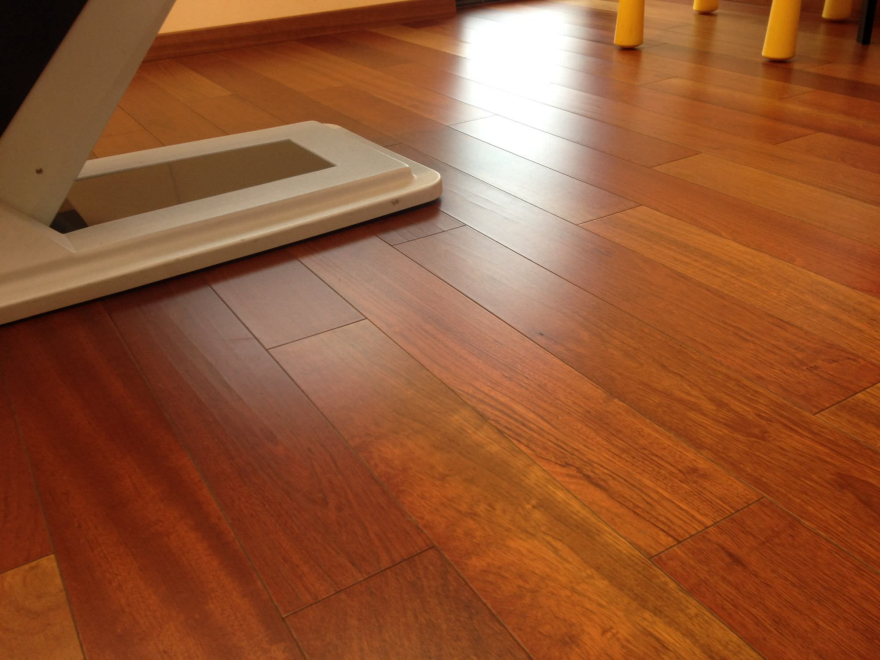
An Introduction to Wood Species, Part 15: Jatoba / "Brazilian Cherry"
Hard, stable, and durable enough for both indoor and outdoor use
Jatoba
Hymenaea courbaril
 Enter a caption (optional)
Enter a caption (optional)Jatoba is probably most commonly known in North America as "Brazilian Cherry" and it has been adopted largely by the flooring industry. The deep red color is stunning and the hardness and stability make it an excellent flooring option so this adoption is pretty natural. But Jatoba is no one trick pony and its applications span from inside to outside construction and is commonly used as decking, siding, and exterior furniture. Like most tropical woods, Jatoba is highly resistant to rot and insects, but it can actually be the more preferable wood to use. While dense it is not nearly as dense and heavy as some of its other Brazilian brothers like Ipe and Cumaru. This slightly lower density means it is still very durable yet it will acclimate better during the adjustment period from lumber yard to installation and from season to season.
 Enter a caption (optional)
Enter a caption (optional) Freshly milled Jatoba is a light reddish brown
Freshly milled Jatoba is a light reddish brown  Here is a sample of Jatoba that has been sunned for several days
Here is a sample of Jatoba that has been sunned for several days Jatoba is another wood that will change color after it is milled. Initially the wood is quite light in color and over time it darkens into a deep red. Eventually, like all wood in exterior situations, it will gray in sunlight unless regularly treated. The color change is pretty fast and freshly milled Jatoba can darken after an afternoon spent in the sun.
 Enter a caption (optional)
Enter a caption (optional)The greatest feature of Jatoba is the versatility to use both inside and out. With a strong trend towards outdoor living spaces and merging them to the interior spaces, Jatoba is an excellent choice for your flooring and decking to create a unified living space with beautiful and durable wood throughout.
 Enter a caption (optional)
Enter a caption (optional)J Gibson McIlvain carries Jatoba for both exterior and interior applications. It is important to recognize that while the same species, these are essentially different products. The exterior decking product is sold as an S4S, E4E (surfaced on 4 sides, eased on 4 edges) that is air dried to around 18% moisture content to allow it to acclimate to most exterior conditions. The interior product is a typical kiln dried hardwood with a moisture content of 6-8% and is sold as rough sawn or it can be milled to whatever profile your project needs here at our onsite millworks.
 Enter a caption (optional)
Enter a caption (optional)_________________________________________________________
This continuation of the Wood Species series is written by Shannon Rogers, a/k/a The Renaissance Woodworker and founder of The Hand Tool School. It has been provided courtesy of the J. Gibson McIlvain Lumber Company, where Rogers works as Director of Marketing.
_________________________________________________________
More Wood Reference:
Species:
» An Introduction To Wood Species, Part 1: Properties & Terminology
» An Introduction To Wood Species, Part 2: Pine
» An Introduction To Wood Species, Part 3: Oak
» An Introduction To Wood Species, Part 4: Maple
» An Introduction To Wood Species, Part 5: Walnut
» An Introduction To Wood Species, Part 6: Cherry
» An Introduction To Wood Species, Part 7: Mahogany
» An Introduction To Wood Species, Part 8: Rosewood
» An Introduction To Wood Species, Part 9: Ebony
» An Introduction To Wood Species, Part 10: Teak
How Boards are Made:
» How Logs Are Turned Into Boards, Part 1: Plainsawn
» How Logs Are Turned Into Boards, Part 2: Quartersawn
» How Logs Are Turned Into Boards, Part 3: Riftsawn
Wood Movement:
» Wood Movement: Why Does Wood Move?
-
oFavorite This
-
QComment
K
{Welcome
Create a Core77 Account
Already have an account? Sign In
By creating a Core77 account you confirm that you accept the Terms of Use
K
Reset Password
Please enter your email and we will send an email to reset your password.

